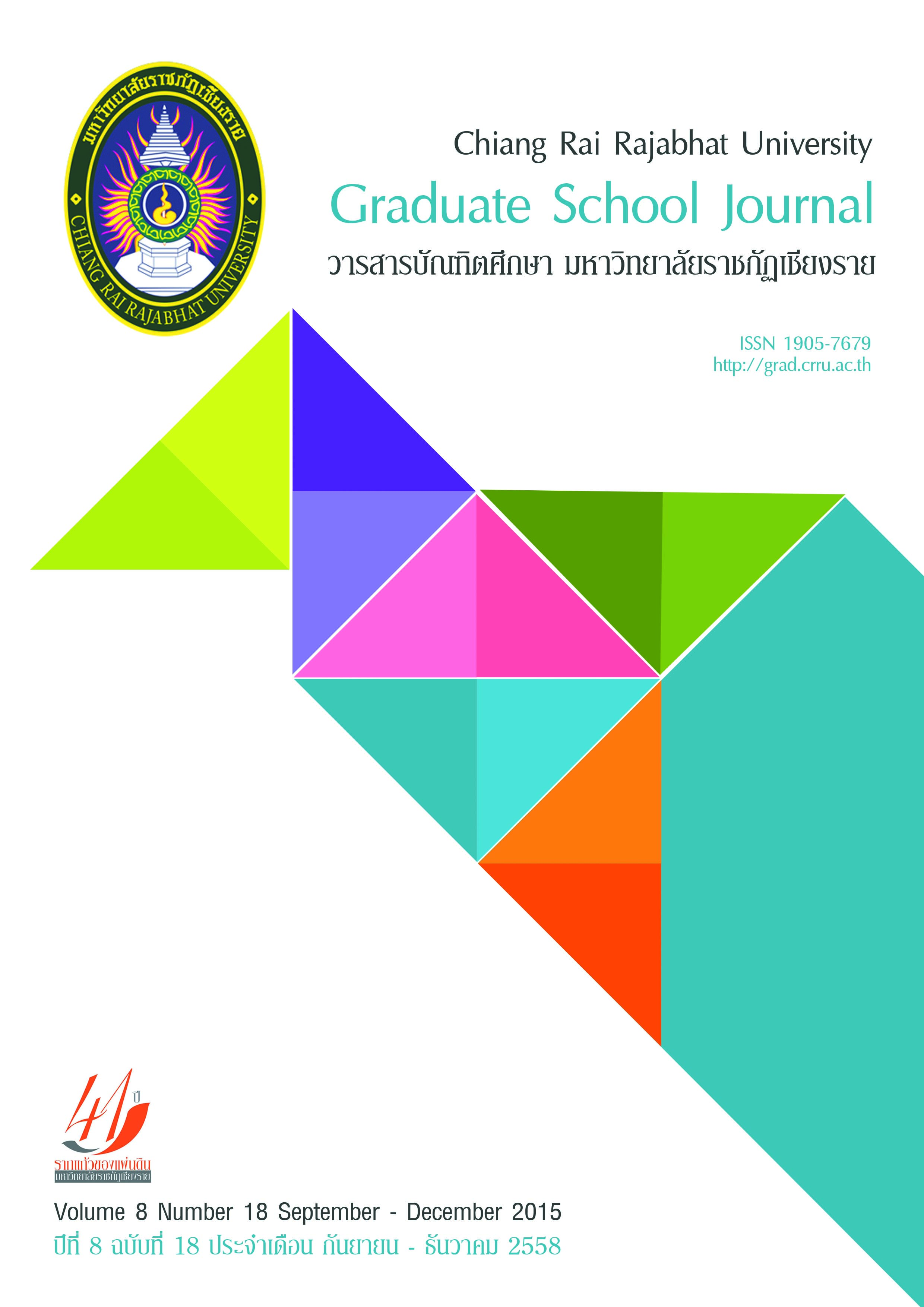‘Tibok’ Argot Nonverbal Communication in Thailand
Main Article Content
บทคัดย่อ
The purpose of this study aimed to analyze the Tibok argot nonverbal communication in Thailand, including parts of speech, syntactic structures of Tibok and other linguistic features. Data were collected and analyzed by descriptive and qualitative design using observations, interviews and document studies as the research instruments. Data collection process and instruments were employed by the key informants who had experienced in using Tibok argot for three years and lived in Chiangrai Province. The results were found as follows: 1) The part of speech found in Tibok argot sorted from the most to the least which were: verbs (44.10%), nouns (26.15%), adjectives (15.38%), adverbs (4.10%), prepositions (3.59%), pronouns (1.03%), conjunction (0.51%) respectively. In this study, it was also found other features (5.13%) appeared in Tibok. 2) Syntactic structures of Tibok found in this study could be classified into declarative, interrogative and negative sentences and 3) Other linguistic features were found in some figures of Tibok argot which could not be categorized. The two features were: different figures referred to the same meaning and same figures referred to different meanings. Besides, there were not only explicit meanings but also implicit meanings.
‘ตีโบก’ อวจนภาษาเพื่อการสื่อสารในประเทศไทย
การศึกษาครั้งนี้ มีวัตถุประสงค์ เพื่อวิเคราะห์ภาษาที่ปรากฏใน ‘ตีโบก’ อวจนภาษาในประเทศไทย ซึ่งประกอบด้วย ชนิดของคำ รูปแบบประโยค และลักษณะทางภาษาศาสตร์อื่น ๆ รวบรวมข้อมูลและวิเคราะห์ข้อมูลโดยเก็บรวบรวมข้อมูลจาก การสังเกต สัมภาษณ์ผู้ให้ข้อมูลหลัก รวมทั้ง ศึกษาข้อมูลที่เป็นเอกสารจากผู้ให้ข้อมูลหลักซึ่งเป็นผู้ที่มีประสบการณ์ มาเป็นเวลา 3 ปี และอาศัยอยู่ในจังหวัดเชียงราย ผลการศึกษาพบว่า 1) ชนิดของคำ ที่พบใน ‘ตีโบก’ อวจนภาษา เรียงลำดับจากมากไปหา น้อย ดังนี้ คำกริยา (44.10%) คำนาม(26.15%) คำคุณศัพท์(15.38%) กริยาวิเศษณ์(4.10%) คำบุพบท(3.59%), คำสรรพนาม (1.03%) คำสันธาน (0.51%) ตามลำดับ นอกจากนั้น พบว่า มีลักษณะทางภาษาอื่นๆ(5.13%) ที่พบในการศึกษาครั้งนี้ 2) รูป แบบประโยค จำแนกออกเป็น 3 รูปแบบ ได้แก่ บอกเล่าทั่วไป คำถาม และปฏิเสธ และ 3) ลักษณะทางภาษาศาสตร์อื่นๆ ที่พบ ใน‘ตีโบก’ อวจนภาษา พบว่ามีข้อแตกต่างที่ไม่สามารถนำมาจัดประเภทกับกลุ่มที่กล่าวมาข้างต้นได้ จำนวน 2 รูปแบบ คือ ใช้ ภาษาท่าทางที่แตกต่างกันแต่ให้ความหมายเดียวกันและใช้ท่าทางที่เหมือนกันแต่ให้ความหมายแตกต่างกัน นอกจากนั้น การแปล ความหมายของภาษา มีทั้งความหมายตรงและความหมายแฝง
Article Details
บทความที่ได้รับการตีพิมพ์เป็นลิขสิทธิ์ของวารสารมหาวิทยาลัยราชภัฎเชียงราย
ข้อความที่ปรากฏในบทความแต่ละเรื่องในวารสารวิชาการเล่มนี้เป็นความคิดเห็นส่วนตัวของผู้เขียนแต่ละท่านไม่เกี่ยวข้องกับมหาวิทยาลัยราชภัฎเชียงราย และคณาจารย์ท่านอื่นๆในมหาวิทยาลัยฯ แต่อย่างใด ความรับผิดชอบองค์ประกอบทั้งหมดของบทความแต่ละเรื่องเป็นของผู้เขียนแต่ละท่าน หากมีความผิดพลาดใดๆ ผู้เขียนแต่ละท่านจะรับผิดชอบบทความของตนเองแต่ผู้เดียว


